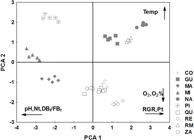Most rivers are used as a source to supply entire cities; the quality of water is directly related to the quality of tributaries. Unfortunately men have neglected the importance of streams, which receive domestic and industrial effluents and transport nutrients and pesticides from rural areas. Given the complexity of the mixtures discharged into these water bodies, this study aimed to evaluate the quality of water and sediment of ten tributaries of Pirapó River, in Maringá, Paraná State, Brazil. To this end, the free-floating macrophyte Landoltia punctata (G. Meyer) Les & D.J.Crawford was used as test organism in microcosm, and the toxicity of water and sediment samples was evaluated by the relative growth rate, dry/fresh biomass ratio, and genotoxic effects (comet assay). Samples of water and sediment of each stream were arranged in microcosms with L. punctata. Seven days later, plants were collected for analysis. Nutrient levels were higher than the reference location, indicating eutrophication, but the results indicated a toxic effect for only three streams, and a genotoxic effect for all streams.
Ecotoxicology; aquatic macrophyte; microcosm; anthropogenic pollution; comet assay

 Thumbnail
Thumbnail
 Thumbnail
Thumbnail
 Thumbnail
Thumbnail
 Thumbnail
Thumbnail
 Thumbnail
Thumbnail
 Thumbnail
Thumbnail





